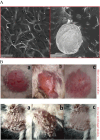Progress in the application of nanoparticles for the treatment of fungal infections: A review
- PMID: 38558835
- PMCID: PMC10977003
- DOI: 10.1080/21501203.2023.2285764
Progress in the application of nanoparticles for the treatment of fungal infections: A review
Abstract
The burden of fungal infections on human health is increasing worldwide. Aspergillus, Candida, and Cryptococcus are the top three human pathogenic fungi that are responsible for over 90% of infection-related deaths. Moreover, effective antifungal therapeutics are lacking, primarily due to host toxicity, pathogen resistance, and immunodeficiency. In recent years, nanomaterials have proved not only to be more efficient antifungal therapeutic agents but also to overcome resistance against fungal medication. This review will examine the limitations of standard antifungal therapy as well as focus on the development of nanomaterials.
Keywords: Fungal infection; antifungal; nanoparticle.
© 2023 The Author(s). Published by Informa UK Limited, trading as Taylor & Francis Group.
Conflict of interest statement
No potential conflict of interest was reported by the author(s).
Figures


Similar articles
-
Dectin-2-Targeted Antifungal Liposomes Exhibit Enhanced Efficacy.mSphere. 2019 Oct 30;4(5):e00715-19. doi: 10.1128/mSphere.00715-19. mSphere. 2019. PMID: 31666315 Free PMC article.
-
Development and research progress of anti-drug resistant fungal drugs.J Infect Public Health. 2022 Sep;15(9):986-1000. doi: 10.1016/j.jiph.2022.08.004. Epub 2022 Aug 10. J Infect Public Health. 2022. PMID: 35981408 Review.
-
A comprehensive review on potential applications of metallic nanoparticles as antifungal therapies to combat human fungal diseases.Saudi Pharm J. 2023 Sep;31(9):101733. doi: 10.1016/j.jsps.2023.101733. Epub 2023 Aug 6. Saudi Pharm J. 2023. PMID: 37649674 Free PMC article. Review.
-
The use of nanoparticles as alternative therapeutic agents against Candida infections: an up-to-date overview and future perspectives.World J Microbiol Biotechnol. 2020 Sep 29;36(11):163. doi: 10.1007/s11274-020-02940-0. World J Microbiol Biotechnol. 2020. PMID: 32990838 Review.
-
Using inorganic nanoparticles to fight fungal infections in the antimicrobial resistant era.Acta Biomater. 2023 Mar 1;158:56-79. doi: 10.1016/j.actbio.2023.01.019. Epub 2023 Jan 11. Acta Biomater. 2023. PMID: 36640952 Review.
Cited by
-
The kinase Bud32 regulates iron homeostasis in fungal pathogen Cryptococcus neoformans.Front Immunol. 2025 Jul 25;16:1624237. doi: 10.3389/fimmu.2025.1624237. eCollection 2025. Front Immunol. 2025. PMID: 40787456 Free PMC article.
-
Unlocking the potential of titanium dioxide nanoparticles: an insight into green synthesis, optimizations, characterizations, and multifunctional applications.Microb Cell Fact. 2024 Dec 23;23(1):341. doi: 10.1186/s12934-024-02609-5. Microb Cell Fact. 2024. PMID: 39710687 Free PMC article. Review.
-
Molecular Phylogeny and Morphology Reveal Four New Species of Conocybe (Bolbitiaceae, Agaricales) from the Qinghai-Xizang Plateau, China.J Fungi (Basel). 2025 Jan 7;11(1):45. doi: 10.3390/jof11010045. J Fungi (Basel). 2025. PMID: 39852464 Free PMC article.
-
Species Diversity of Gymnopus Section Levipedes in Southwestern China, with a Description of Three New Species.J Fungi (Basel). 2025 Jan 23;11(2):88. doi: 10.3390/jof11020088. J Fungi (Basel). 2025. PMID: 39997382 Free PMC article.
-
Garlic-Derived Quorum Sensing Inhibitors: A Novel Strategy Against Fungal Resistance.Drug Des Devel Ther. 2024 Dec 28;18:6413-6426. doi: 10.2147/DDDT.S503302. eCollection 2024. Drug Des Devel Ther. 2024. PMID: 39749188 Free PMC article. Review.
References
Publication types
LinkOut - more resources
Full Text Sources
